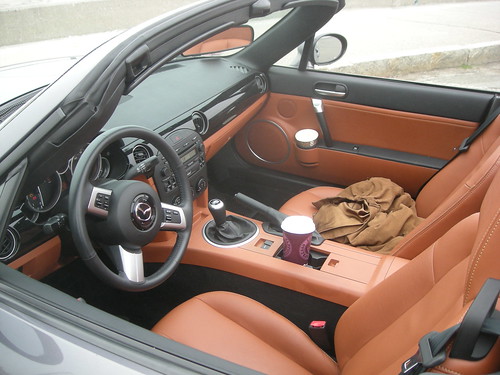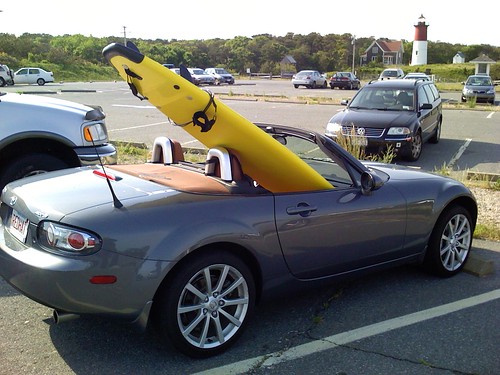



Photos: A year with my Mazda MX-5.
So, this time last year, I was fairly pissed off with the world (mostly over a particular girl) and decided to cheer myself up with retail therapy. After various other craziness, I found myself in a car dealership one afternoon, looking at MX5s.
Now I’d never had a (full) driver’s license in the UK. I’d learned to drive, but never really sorted out the final getting-the-license bit. I relied on friends, family, and UK public transportation for 24 years. But there’s only so long that this lasts you in the US (I’m talking about the ability to drive, even a rental car for an afternoon, not even owning a car), where many activities require some form of vehicular transportation – for example, getting to the office (before the shuttle service we have now existed), which is 37 miles outside of Boston. It was inevitable that I would learn to drive “on the right side of the road” sooner or later, all I needed was a little impetus to get that moving.
The impetus was being really pissed off with the world, over a girl (as begins many a story in life). Within 3 days of her randomly deciding not to see me again for no reason, I’d had a few lessons on US driving, and one week later, I had the passed the testing (no silly many months of waiting list like in the UK, though the standards here are shockingly lower than in the UK – conversely, there the DSA (Driving Standards Authority) is overly anal, out of touch with reality, poorly (mis)managed, and generally a giant government was of time). The first time I drove alone was on a roadtrip to New York in a rental car. The second time was an extreme amount of Californian coastal highway driving, including 74 miles of twisting, winding mountainous roads. That was April.
By June, I was still pretty pissed off with the world (I’d even briefly considered whether to leave the country and go somewhere else entirely – I can now completely sympathize with a certain hacker who moved to Australia), had spent a few weekends tearing up the Californian countryside in rental cars, and decided I needed to get a car. Initially, I planned to be fairly sane, and buy something like a Prius, or an older (but dirt cheap) used car. Then I discovered two things:
1. Insurance in Massachusetts is regulated by the State of Massachusetts (there are changes underway this year, but it’s all largely cosmetic), and auto insurance would cost me at least 3K/year, regardless of my vehicle.
2. There are some surprisingly affordable cars in the US, when you’re used to UK prices – my car in the UK retails for around twice as much as I paid for it, which isn’t particular atypical, though most of the time it’s slightly less.
So, if I was going to pay through the nose, I might aswell have fun while doing it. I started looking at MX5s. Initially, I was looking at older used models, with the older pre-2006 design. But there was really something about the complete redesign for the 2006 model year that did it for me. This model had more class, more leg room, and more cup-holders (everyone knows you should always judge a US car by the number of cup holders). I rented one in California and took it for a spin up the route 1 highway. I liked it. A lot. Even if it was an automatic rental. So, that pretty much made the decision for me. I planned on getting a standard one, 5 speed, with regular interior, which I was almost about to do when at the dealership I noticed another vehicle:
* 2006 Mazda MX-5.
* Under 10K miles.
* 6 speed manual.
* All the extras.
And let’s not forget I’d committed the carnal sin of being super pissed off with the world, and simultaneously being in a car dealership at the same time. These things are known to be bad in combination. I picked it up in time to drive up to OLS last year. Then I had some fun registering the license plate “RED HAT”, because, well, it was available and nobody else had thought to get it first. It amused me.
Last summer was an interestingly, terrifying, Boston driving experience. I was a newly qualified driver, in a almost new car, surrounded by crazy Boston drivers. This meant I never drove in town, would only go to specific places, and I tried to avoid doing anything that would get me lost. Still, I had a lot of fun with the freedom that vehicle ownership gives you – especially a convertible in a New England summer. I drove to the beach (a lot, especially at 4 or 5am to watch the sunrise, and sometimes also in the evening for the inverse), went to my first ever drive-in movie, and did some other local trips like Blueberry picking. I also drove up to Canada the day after getting it.
Time passed, the fall came, and I bought a GPS (complete with optional, extremely pretentious over-done stereotype-in-a-box British accent – not that one, before you think so). This changed my driving experience considerably. Now I didn’t have to be so worried about dying constantly and could just focus on avoiding the maniacs on the road, rather than trying to navigate. And if you don’t think Boston drivers are insane, well, you’ve probably never seen the contrast between American and British drivers first hand. There’s no cup-of-tea niceness here, only bloodthirsty vengeance, a constant need to cut people up, and a desire never to use signals. I started going to other places I hadn’t previously tried to get to in my car – New York, other States, even eventually driving around town, although I still like to avoid doing that – the MBTA “T” is actually far more effective, in many cases.
With the passing of the fall, winter came in, and it was harsh. My low profile sport tires really weren’t much of a match for New England snow, but I was determined to live my Californian driving lifestyle. I’m probably the only person I know who drives around with the top down in January, when it’s -10 outside, wearing mountain gloves. While that’s perfectly possible, and clearing snow from the car to achieve that takes under 30 minutes, driving on snow turns out to be sufficiently more difficult than I had anticipated. I probably had a number of near-calls, and certainly need to look into snow tires for this year’s winter weather craziness. I’ve upgraded my gloves, too.
Anyway. After a year of owning this thing, and my first annual inspection (and insurance renewall…), I’ve decided I made the right choice in a car. Mazda pretty much got this right. Sure, it’s not the S-2000. And yes, that is a very lovely car, but it’s also nearly 20K more than the Mazda, and I’m not sure really whether it’s worth that. The car interior is almost as close to ideal as one could get – though the door cup holders might be better placed. It’s small, but well laid out, the controls are done right, the soft top release is much improved on the older model (to the point where you can put the top down, in moving traffic, using one hand), and even the trunk size is ok, just so long as you advise guests in advance not to bring huge suitcases when they fly in.
On the whole, I’d thoroughly recommend the MX5. I went to my first ever auto show this year also, and saw the latest model before it really started to hit the roads. They’ve really only made a few cosmetic changes – though they do now have Active Stability Control as standard on my model (well, one presumes), the access control is improved, and they’ve slightly tweaked a few cosmetic items…but on the whole, it’s still just about right. Don’t buy it if you’ve got a family or ever like to travel with more than an overnight bag 
Jon.



